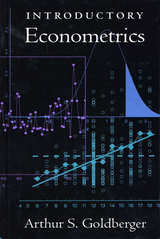
This text prepares first-year graduate students and advanced undergraduates for empirical research in economics, and also equips them for specialization in econometric theory, business, and sociology.
A Course in Econometrics is likely to be the text most thoroughly attuned to the needs of your students. Derived from the course taught by Arthur S. Goldberger at the University of Wisconsin–Madison and at Stanford University, it is specifically designed for use over two semesters, offers students the most thorough grounding in introductory statistical inference, and offers a substantial amount of interpretive material. The text brims with insights, strikes a balance between rigor and intuition, and provokes students to form their own critical opinions.
A Course in Econometrics thoroughly covers the fundamentals—classical regression and simultaneous equations—and offers clear and logical explorations of asymptotic theory and nonlinear regression. To accommodate students with various levels of preparation, the text opens with a thorough review of statistical concepts and methods, then proceeds to the regression model and its variants. Bold subheadings introduce and highlight key concepts throughout each chapter.
Each chapter concludes with a set of exercises specifically designed to reinforce and extend the material covered. Many of the exercises include real microdata analyses, and all are ideally suited to use as homework and test questions.

This is a textbook for the standard undergraduate econometrics course. Its only prerequisites are a semester course in statistics and one in differential calculus. Arthur Goldberger, an outstanding researcher and teacher of econometrics, views the subject as a tool of empirical inquiry rather than as a collection of arcane procedures. The central issue in such inquiry is how one variable is related to one or more others. Goldberger takes this to mean "How does the average value of one variable vary with one or more others?" and so takes the population conditional mean function as the target of empirical research.
The structure of the book is similar to that of Goldberger's graduate-level textbook, A Course in Econometrics, but the new book is richer in empirical material, makes no use of matrix algebra, and is primarily discursive in style. A great strength is that it is both intuitive and formal, with ideas and methods building on one another until the text presents fairly complicated ideas and proofs that are often avoided in undergraduate econometrics.
To help students master the tools of econometrics, Goldberger provides many theoretical and empirical exercises and real micro-and macroeconomic data sets. The data sets, available for download at www.hup.harvard.edu/features/golint/, deal with earnings and education, money demand, firm investment, stock prices, compensation and productivity, and the Phillips curve.
THE DATA SETS CAN BE FOUND HERE.
READERS
Browse our collection.
PUBLISHERS
See BiblioVault's publisher services.
STUDENT SERVICES
Files for college accessibility offices.
UChicago Accessibility Resources
home | accessibility | search | about | contact us
BiblioVault ® 2001 - 2024
The University of Chicago Press









